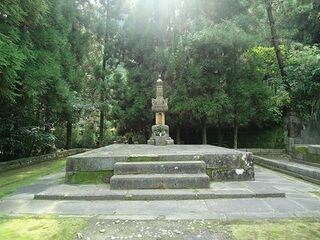Difference between revisions of "Takehime"
| Line 7: | Line 7: | ||
Takehime, or Princess Take, was an adopted daughter of both Shogun [[Tokugawa Yoshimune]] and [[Tokugawa Tsunayoshi]], and wife of [[Shimazu Tsugutoyo]], lord of [[Satsuma han]]. | Takehime, or Princess Take, was an adopted daughter of both Shogun [[Tokugawa Yoshimune]] and [[Tokugawa Tsunayoshi]], and wife of [[Shimazu Tsugutoyo]], lord of [[Satsuma han]]. | ||
| − | She was born in [[Kyoto]], the daughter of [[Dainagon]] [[Seikanji Hirosada]]<!--清閑寺凞定-->, and was brought at a very young age to [[Edo]] to meet her aunt, who was a concubine to Shogun Tokugawa Tsunayoshi. She was adopted by Tsunayoshi in [[1708]] (at age 3), and was engaged to [[Matsudaira Masakuni]], lord of [[Aizu han]], and then to Prince [[Arisugawa | + | She was born in [[Kyoto]], the daughter of [[Dainagon]] [[Seikanji Hirosada]]<!--清閑寺凞定-->, and was brought at a very young age to [[Edo]] to meet her aunt, who was a concubine to Shogun Tokugawa Tsunayoshi. She was adopted by Tsunayoshi in [[1708]] (at age 3), and was engaged to [[Matsudaira Masakuni]], lord of [[Aizu han]], and then to Prince [[Arisugawa Tadahito]], but both died before they were married. Tsunayoshi, along with [[Konoe Hiroko]] (wife of Tsunayoshi's heir [[Tokugawa Ienobu]]) and [[Renjo-in|Renjô-in]] (one of Ienobu's prominent concubines), then made a proposal to Shimazu Tsugutoyo, which was resisted (on account of fears that Tsugutoyo would die as her previous fiancées had), but ultimately accepted. Tsugutoyo and Takehime were betrothed, and after Takehime was formally adopted by Tokugawa Yoshimune, the two were married on [[1729]]/12/11. She gave birth to a daughter, [[Kikuhime]], in [[1733]], and raised [[Shimazu Munenobu]] as her adopted son as well. |
Tsugutoyo stepped down as ''daimyô'' in [[1746]], and was succeeded by Munenobu. Tsugutoyo then died in [[1760]]. | Tsugutoyo stepped down as ''daimyô'' in [[1746]], and was succeeded by Munenobu. Tsugutoyo then died in [[1760]]. | ||
| Line 19: | Line 19: | ||
*"[https://kotobank.jp/word/%E5%B3%B6%E6%B4%A5%E7%B6%99%E8%B1%8A-1080940 Shimazu Tsugutoyo]," ''Nihon jinmei daijiten'', Kodansha, 2009. | *"[https://kotobank.jp/word/%E5%B3%B6%E6%B4%A5%E7%B6%99%E8%B1%8A-1080940 Shimazu Tsugutoyo]," ''Nihon jinmei daijiten'', Kodansha, 2009. | ||
*"[http://www.shuseikan.jp/word/simadzu09.html Takehime]," ''Satsuma Shimazu-ke no rekishi'', [[Shokoshuseikan|Shôkoshûseikan]] official website. | *"[http://www.shuseikan.jp/word/simadzu09.html Takehime]," ''Satsuma Shimazu-ke no rekishi'', [[Shokoshuseikan|Shôkoshûseikan]] official website. | ||
| + | *Cecilia Segawa Seigle, “Tokugawa Tsunayoshi and the Formation of Edo Castle Rituals of Giving,” in Martha Chaiklin (ed.), ''Mediated by Gifts: Politics and Society in Japan 1350-1850'', 139-140. | ||
[[Category:Edo Period]] | [[Category:Edo Period]] | ||
[[Category:Women]] | [[Category:Women]] | ||
Latest revision as of 15:05, 1 October 2017
Takehime, or Princess Take, was an adopted daughter of both Shogun Tokugawa Yoshimune and Tokugawa Tsunayoshi, and wife of Shimazu Tsugutoyo, lord of Satsuma han.
She was born in Kyoto, the daughter of Dainagon Seikanji Hirosada, and was brought at a very young age to Edo to meet her aunt, who was a concubine to Shogun Tokugawa Tsunayoshi. She was adopted by Tsunayoshi in 1708 (at age 3), and was engaged to Matsudaira Masakuni, lord of Aizu han, and then to Prince Arisugawa Tadahito, but both died before they were married. Tsunayoshi, along with Konoe Hiroko (wife of Tsunayoshi's heir Tokugawa Ienobu) and Renjô-in (one of Ienobu's prominent concubines), then made a proposal to Shimazu Tsugutoyo, which was resisted (on account of fears that Tsugutoyo would die as her previous fiancées had), but ultimately accepted. Tsugutoyo and Takehime were betrothed, and after Takehime was formally adopted by Tokugawa Yoshimune, the two were married on 1729/12/11. She gave birth to a daughter, Kikuhime, in 1733, and raised Shimazu Munenobu as her adopted son as well.
Tsugutoyo stepped down as daimyô in 1746, and was succeeded by Munenobu. Tsugutoyo then died in 1760.
Takehime died in 1772, at the age of 68. She is buried alongside Tsugutoyo and his other wives at the Shimazu clan cemetery at Fukushô-ji, in Kagoshima.
References
- William Fleming, “The World Beyond the Walls: Morishima Chūryō (1756-1810) and the Development of Late Edo Fiction,” PhD dissertation, Harvard University (2011), 94n151.
- "Shimazu Tsugutoyo," Nihon jinmei daijiten, Kodansha, 2009.
- "Takehime," Satsuma Shimazu-ke no rekishi, Shôkoshûseikan official website.
- Cecilia Segawa Seigle, “Tokugawa Tsunayoshi and the Formation of Edo Castle Rituals of Giving,” in Martha Chaiklin (ed.), Mediated by Gifts: Politics and Society in Japan 1350-1850, 139-140.
